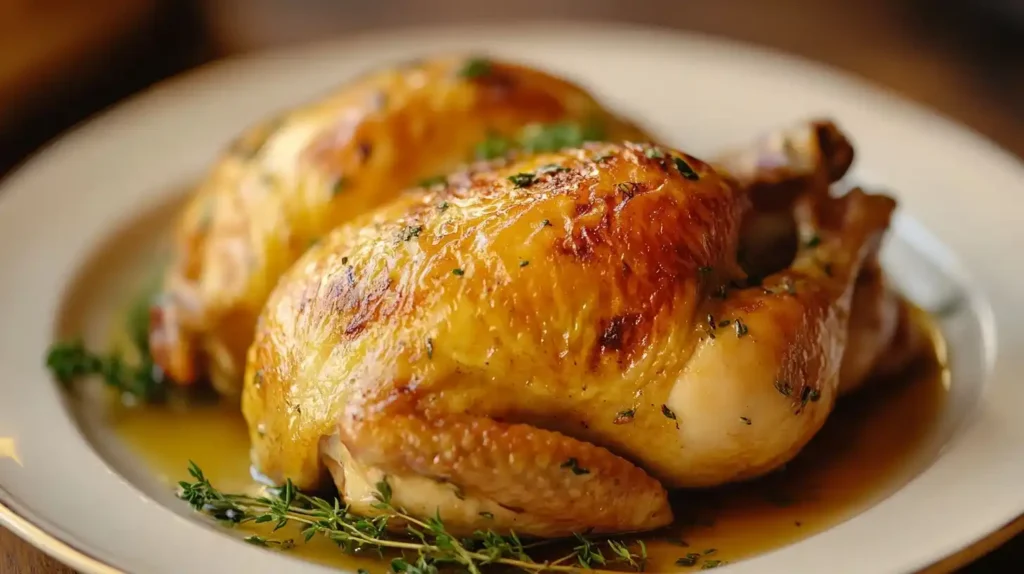Why Is My Braised Chicken Tough?-
Braising is a fantastic cooking method that turns tough cuts of meat into tender, flavorful dishes. But what happens when your braised chicken turns out tough and chewy instead of soft and juicy? I’ve been there, and trust me, it can be frustrating! In this guide, I’ll walk you through the reasons why your braised chicken might be tough and how to fix it so you get perfectly tender results every time.
Place of Origin
Braising has been around for centuries and is a staple cooking method in many cuisines. From French coq au vin to Chinese red-cooked chicken, this technique uses slow cooking in liquid to break down muscle fibers, making the meat tender and full of flavor.

Tips for Selecting High-Quality Ingredients
Choosing the Right Chicken
The quality of your chicken plays a huge role in the final dish. Fresh, organic, or free-range chicken tends to be more tender than frozen or factory-farmed varieties. Additionally, dark meat cuts like thighs and drumsticks work best for braising since they have more connective tissue, which breaks down beautifully during slow cooking.
Importance of Seasonings and Liquids
Braising is all about infusing flavor, so your seasonings and liquids matter. Use aromatic herbs, garlic, onions, and spices to enhance taste. As for the liquid, chicken broth, wine, coconut milk, or tomato sauce can all add depth and richness to your dish.
How to Make Braised Chicken
The key to a perfectly braised chicken is controlling the heat and cooking time. If the temperature is too high or you cook it too quickly, the meat can seize up and become tough instead of tender.

Step-by-Step Guide to Cooking
Step 1 – Preparing the Chicken
Start by patting the chicken dry with paper towels. Season it generously with salt, pepper, and any other spices of your choice. For extra flavor, marinate the chicken for a few hours or overnight.
Step 2 – Searing the Meat
Heat oil in a heavy-bottomed pot or Dutch oven over medium-high heat. Sear the chicken skin-side down until golden brown, then flip and brown the other side. This step locks in flavor and adds a rich, caramelized taste.
Step 3 – Simmering and Braising
Once seared, remove the chicken and deglaze the pot by adding broth, wine, or another liquid. Scrape up the browned bits for extra flavor. Return the chicken to the pot, lower the heat, cover, and let it simmer gently for 45 minutes to 1.5 hours, depending on the cut.
FAQs
How do you fix tough braised meat?
If your chicken turns out tough, don’t panic! Let it continue cooking on low heat with extra liquid. Over time, the connective tissues will break down, making the meat tender.
Why is my chicken tough after I cook it?
Overcooking at high heat or using lean cuts like chicken breast can lead to tough meat. Stick to slow cooking with dark meat cuts for better results.
How can you soften tough chicken?
If your chicken is already tough, try shredding it and simmering it in a sauce or broth for a few more minutes. Adding acidity, like vinegar or lemon juice, can also help break down the fibers.
Why is my braised meat not tender?
If your braised chicken isn’t tender, it may not have cooked long enough. Slow and steady wins the race—low heat and patience are key!
Related Searches
- Why is my braised chicken tough reddit
- Why is my braised chicken tough after cooking
- Why is my braised chicken tough in the oven
- Braised chicken breast
- How to braise meat on the stove
- How to braise meat in oven
- How long to braise chuck roast at 300
- Braised chicken thighs
Now that you know the secrets to perfectly braised chicken, it’s time to put them into practice. Follow these tips, and soon you’ll have melt-in-your-mouth, flavorful chicken every time. Happy cooking!
Explore More Recipes Similar to “Why Is My Braised Chicken Tough?”
If you’re interested in braising techniques and tenderizing chicken, here are some related recipes that might help you improve your cooking skills:
- Can You Overcook Chicken When Braising?
Learn about the risks of overcooking chicken while braising and how to achieve the perfect texture. - What Does Braising Do to Chicken?
Discover the science behind braising and how it affects the tenderness and flavor of chicken. - Braised Chicken with Harissa and Olives
Try this flavorful braised chicken dish infused with North African spices. - How to Make Chicken Not Chewy and Tender
Get expert tips on how to cook juicy and tender chicken every time. - What Is Harissa Made of?
A deep dive into harissa, a flavorful spice blend that can enhance braised chicken dishes.

